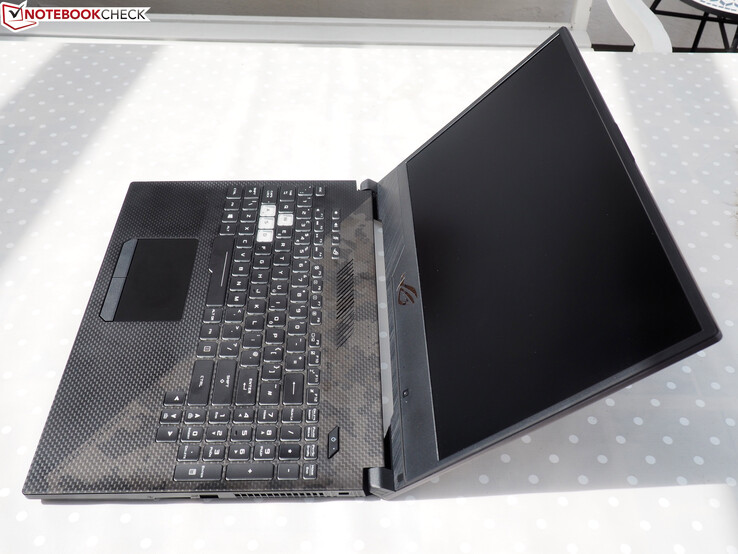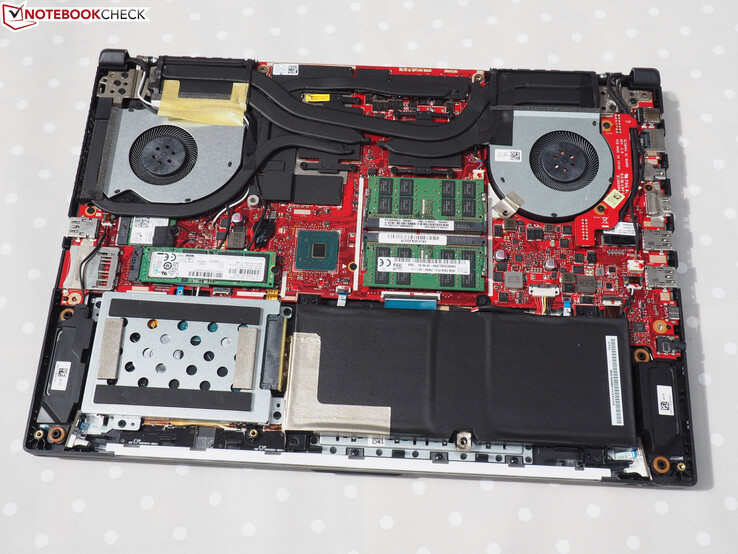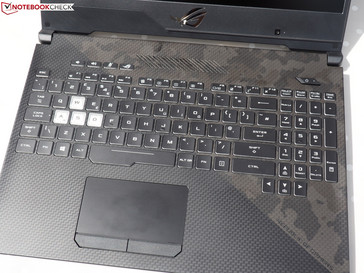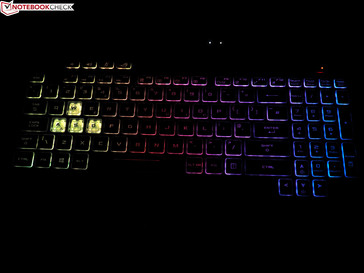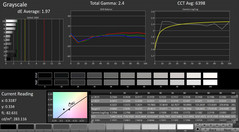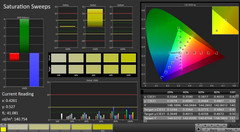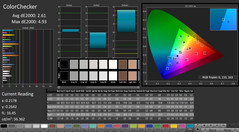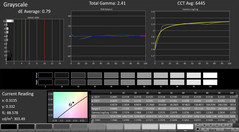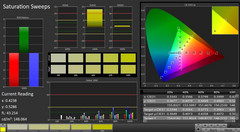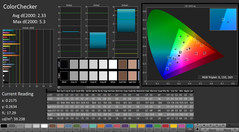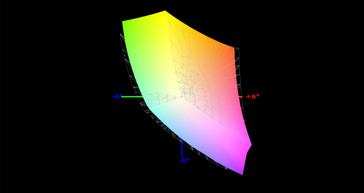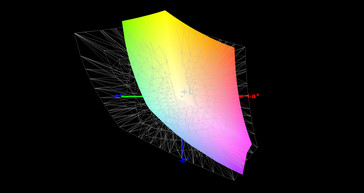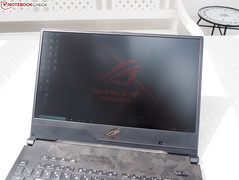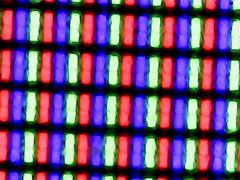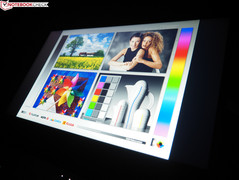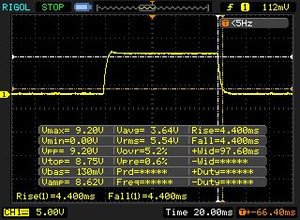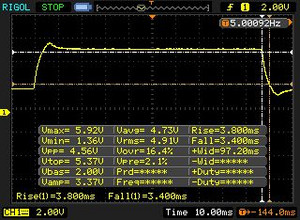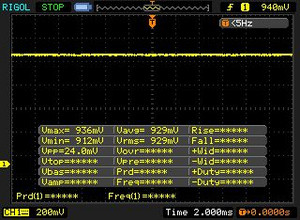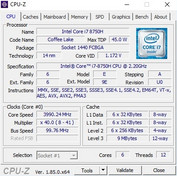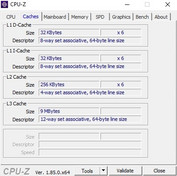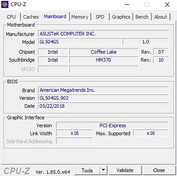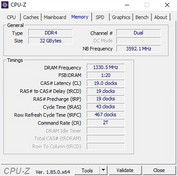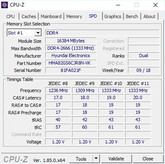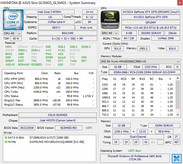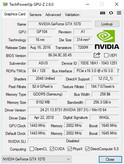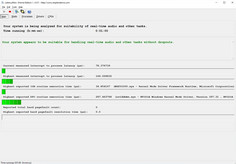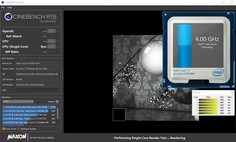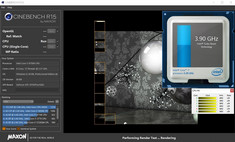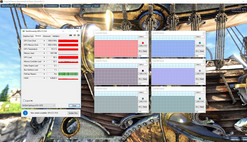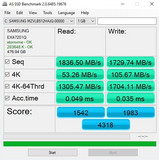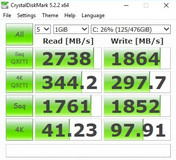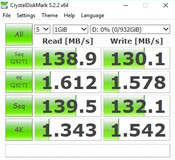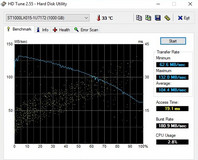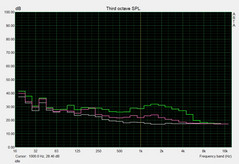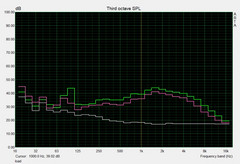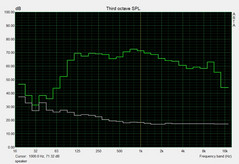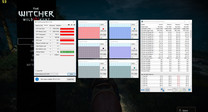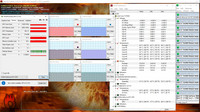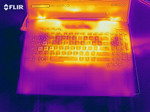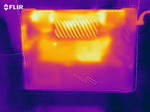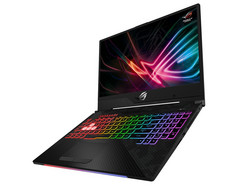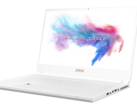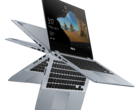Asus ROG Strix GL504 Scar II (i7-8750H, GTX 1070, FHD) Laptop Review

"Thin bezels!" There is hardly another buzz word that is currently as present as this. While TV's and desktop monitors have already had particularly thin bezels for years, this trend is established in laptops only now. After some all-rounders such as the Dell XPS 15 introduced the trend, there are now also more and more gaming notebooks that that please us with their edge-to-edge designs. Here we should mention the Razer Blade 15, the Gigabyte Aero 15X v8, the MSI GS65 8RF, and the Schenker XMG Neo 15, which will all accompany us through this test.
As one of the largest PC manufacturers in the world, ASUS is naturally also following the current trend, presenting a corresponding 15-inch product with the ROG Strix GL504. To attract as many gamers as possible, the laptop is available in two different variants. For one, there is the Hero II, whose specially marked QWER keys are supposed to attract MOBA fans. Then there is also the Scar II that we tested, which is distinguished by a camouflage pattern and emphasizes the WASD area which is important for ego-shooters.
| Model | GL504GM | GL504GS |
|---|---|---|
| Processor | Core i7-8750H or Core i5-8300H | Core i7-8750H or Core i5-8300H |
| Graphics card | GeForce GTX 1060 (6 GB GDDR5) | GeForce GTX 1070 (8 GB GDDR5) |
| RAM | 32 GB DDR4-2666 max. | 32 GB DDR4-2666 max. |
| Storage | 128-512 GB SSD + 1 TB HDD/SSHD | 128-512 GB SSD + 1 TB HDD/SSHD |
| Display | 144 Hz Full-HD IPS | 144 Hz Full-HD IPS |
| G-Sync | no | no |
| Optimus | yes | no |
| Power supply | 180 Watts | 230 Watts |
To give gamers their money's worth, there are only high-end components inside the case. Those who splurge on the top model will not only receive a Core i7-8750H, but also a GeForce GTX 1070. A 144-Hz display frequency, up to 32 GB DDR4-RAM, and a combination of NVMe-SSD and SSHD reinforce the claims of luxury. Will the GL504 be able to grab the crown among the thin-bezel gaming notebooks? We will find out.
Case - Camouflage looks
Compared to the previous generation, a lot has changed in terms of the case. As well as the size and design, the surface pattern has also been reworked. The top of the case is even graced by two different textures. Whether you like the camouflage visuals of the Scar edition or not is a matter of taste. Our impression is that at first glance, you could mistake some spots for chipped-off varnish from some angles. The strange design mixture also extends to the bottom of the case which, corresponding to the C-cover, is "only" made of plastic. The lid, on the other hand, is made from brushed metal, giving it above-average sturdiness. The base unit is also quite robust and can only be bent or pushed in by using a significant amount of force.
Due to the status of our test unit as a pre-production sample, we cannot give any final comments on the workmanship yet. Our test unit was quite convincing in this regard, however. Nice: not only should some illumination fetishists be pleased wth the RGB keyboard, but also with a multi-colored LED strip in the notebook front. Yet as already mentioned, the main highlight is still the very slim bezel, provided you disregard the bottom segment, which is often noticeably smaller in the competitors.
Apropos, "slim": While at a height of 2.6 cm (~1 in) the GL504 appears to be very slim compared to conventional gaming notebooks, it does not come close to the skinniness of the Razer Blade 15 (17 mm/~0.66 in), the MSI GS65 (18 mm/~0.7 in), the Gigabyte Aero 15X (18 mm/~0.7 in), or the Schenker XMG Neo 15 (22 mm/~0.9 in). Things look similar with the weight, where you can still transport 2.5 kg (~5.5 lb) in relative comfort, but the competitors are much lighter at 1.8 - 2.1 kg (~4 - 4.6 lb).
This is not surprising, considering that Asus forgoes Nvidia's Max-Q technology, which is suggested particularly for very compact devices. We also do not really understand the decision against Nvidia's Optimus graphics switching (this concerns only the GTX-1070 version), especially since there is no G-Sync on board either. The hinges on the GL504 make a good impression. Even though they are quite stiff, the base unit does not move when opening the lid. Surface vibrations only cause the lid to wobble to a limited extent.
Features - Software Eldorado
Connections
As up-to-date as the GL504 is in many respects, there would still be room for improvement in terms of the connections. Even though two of the total of four USB ports support the 3.1-Gen2 protocol, we are looking in vain for Thunderbolt 3 to use external GPUs and other peripherals. The rest of the connections follow the gaming standard and include an RJ45 port, an audio port (combined headphones/microphone), a card reader, and an opening for Kensington Locks. You can connect desktop monitors via either HDMI 2.0 or Mini-DisplayPort 1.2.
The positioning of the connections particularly benefit right-handed users. Since most of the ports are gathered on the left side, a mouse plugged into the right side has lots of room to move.
SD Card Reader
At 79-82 MB/s, the performance of the card reader settles between that of the Gigabyte Aero 15X which is 2-3 times as fast (191-242 MB/s) and the much slower Schenker XMG Neo 15 (25-32 MB/s). The MSI GS65 and the Razer Blade 15 must do without a card reader and are therefore missing from the placement.
| SD Card Reader | |
| average JPG Copy Test (av. of 3 runs) | |
| Gigabyte Aero 15X v8 (Toshiba Exceria Pro SDXC 64 GB UHS-II) | |
| Average of class Gaming (20 - 210, n=66, last 2 years) | |
| Asus GL504GS (Toshiba Exceria Pro SDXC 64 GB UHS-II) | |
| Schenker XMG Neo 15 (Toshiba Exceria Pro SDXC 64 GB UHS-II) | |
| maximum AS SSD Seq Read Test (1GB) | |
| Gigabyte Aero 15X v8 (Toshiba Exceria Pro SDXC 64 GB UHS-II) | |
| Average of class Gaming (25.8 - 261, n=63, last 2 years) | |
| Asus GL504GS (Toshiba Exceria Pro SDXC 64 GB UHS-II) | |
| Schenker XMG Neo 15 (Toshiba Exceria Pro SDXC 64 GB UHS-II) | |
Communication
There are hardly any differences between the comparison devices in the wireless communication. With the exception of the Gigabyte Aero 15X which has a slightly-aging wireless module, all the thin-bezel gaming notebooks offer very current Wi-Fi adapters from Rivet Networks or Intel. Besides the Killer Wireless-AC 1550, the Wireless-AC 9260 and 9560 also achieve top-notch values. In our WLAN test (1 meter/~3 ft distance to the Linksys EA8500 reference router), most of the devices achieve close to the 700-Mbit mark.
| Networking | |
| iperf3 transmit AX12 | |
| Asus GL504GS | |
| Schenker XMG Neo 15 | |
| MSI GS65 8RF-019DE Stealth Thin | |
| Razer Blade 15 2018 | |
| Gigabyte Aero 15X v8 | |
| iperf3 receive AX12 | |
| Schenker XMG Neo 15 | |
| Gigabyte Aero 15X v8 | |
| Razer Blade 15 2018 | |
| Asus GL504GS | |
| MSI GS65 8RF-019DE Stealth Thin | |
Software
As we are accustomed from Asus, the system includes a large number of various tools that are all bundled in the well-known Gaming Center. While GameVisual handles the display output, Aura is responsible for the keyboard illumination and the LED strip. The sound can be adjusted extensively via Sonic Studio and Sonic Rader. Naturally for the elite in 2018, a fan control is also included. We are using the Balanced mode for our tests, and in the Silent and Overboost modes, the measurements can vary significantly.
Accessories
The accessories included with our evaluation sample are limited to a key chain and various stickers. As a power supply for the GTX-1070 version, Asus includes a 230-watt model (180 watts for the GTX 1060) that weighs about 0.6 kg (~1.3 lb) and measures 16.5 x 7.5 x 3 cm (~6.5 x 3 x 1.2 in).
Maintenance
In terms of the maintenance, there are no big surprises. After you have removed all the Philips screws from the D-cover, you can completely remove the bottom plate (for which you will need a flat prying tool, however). Under the hood, you can find not only the wireless module and the battery, but also two DDR4-RAM banks, one M.2 slot of Type 2280, and one 2.5-inch slot. The cooling system consists of two fans that are connected with several heat pipes.
Warranty
Asus offers a two-year warranty on the 15-inch notebook. Please see our Guarantees, Return policies and Warranties FAQ for country-specific information.
Input Devices - Optimized for shooters
Keyboard
The input devices do not need to hide behind the competitors at all. Unlike some other Asus laptops whose keyboards feel a bit spongy (look at the G752, for example), the keyboard in the ROG Strix feels quite crisp and tight, which ensures a high accuracy. Whether you can appreciate the transparent WASD area is a matter of your personal tastes. Thanks to its bright lettering and the configurable RGB illumination, the keyboard stands out regardless, be it day or night.
The manufacturer also deserves some credit for the practical special keys which allow you to adjust the volume, deactivate the microphone, and open the Gaming Center. Since our test unit is a UK version, we cannot offer a final evaluation on the (German) layout yet. We can definitely give some praise for the separated Arrow keys and the enlarged Enter key. Only the combined Insert/Delete key stood out as a negative point to the author. Despite the limited space, Asus has still managed to fit a dedicated number block, although its keys turned out quite small.
Touchpad
For the touchpad, the manufacturer uses a classic variant with "real" mouse keys. Although the surface is very smooth, the sliding characteristics could have been better, particularly with moist or greasy fingers. In terms of the multi-touch support, there are hardly any reasons for complaint. Two finger gestures such as zooming or scrolling work mostly smoothly. The precision is also inconspicuous to a large extent.
The dimensions of the touchpad are on a typical 15-inch level, and 10.7 x 5.9 cm (4.2 x 2.3 in) are neither particularly large, nor particularly small. However, Asus should improve on the noise of the mouse keys, which although sounding well defined, also make quite a clatter and are much louder than the keyboard.
Display - Winner in the response time
While Razer, Gigabyte, and Schenker trust the 144-Hz displays from LG Philips (LGD05C0), Asus is using a panel from AU Optronics for the GL504, whose label is slightly different from the display of the MSI GS65 (B156HAN08.2 instead of B156HAN08.0).
| |||||||||||||||||||||||||
Brightness Distribution: 86 %
Center on Battery: 271 cd/m²
Contrast: 847:1 (Black: 0.32 cd/m²)
ΔE ColorChecker Calman: 2.61 | ∀{0.5-29.43 Ø4.78}
calibrated: 2.33
ΔE Greyscale Calman: 1.97 | ∀{0.09-98 Ø5}
90% sRGB (Argyll 1.6.3 3D)
59% AdobeRGB 1998 (Argyll 1.6.3 3D)
66% AdobeRGB 1998 (Argyll 3D)
90.2% sRGB (Argyll 3D)
66.4% Display P3 (Argyll 3D)
Gamma: 2.4
CCT: 6398 K
| Asus GL504GS AU Optronics B156HAN08.2 (AUO82ED), IPS, 1920x1080 | Razer Blade 15 2018 LGD05C0, IPS, 1920x1080 | Gigabyte Aero 15X v8 LGD05C0, IPS, 1920x1080 | MSI GS65 8RF-019DE Stealth Thin AU Optronics B156HAN08.0 (AUO80ED), IPS, 1920x1080 | Schenker XMG Neo 15 LGD05C0, IPS, 1920x1080 | |
|---|---|---|---|---|---|
| Display | 0% | -1% | 1% | 0% | |
| Display P3 Coverage (%) | 66.4 | 64.3 -3% | 63.6 -4% | 66.2 0% | 64.3 -3% |
| sRGB Coverage (%) | 90.2 | 93.7 4% | 93.8 4% | 92.1 2% | 94.1 4% |
| AdobeRGB 1998 Coverage (%) | 66 | 65.5 -1% | 64.9 -2% | 67.2 2% | 65.3 -1% |
| Response Times | -88% | -80% | -95% | -66% | |
| Response Time Grey 50% / Grey 80% * (ms) | 7.2 ? | 17.2 ? -139% | 16.8 ? -133% | 17.6 ? -144% | 16 ? -122% |
| Response Time Black / White * (ms) | 8.8 ? | 12 ? -36% | 11.2 ? -27% | 12.8 ? -45% | 9.6 ? -9% |
| PWM Frequency (Hz) | |||||
| Screen | 2% | 21% | 11% | 8% | |
| Brightness middle (cd/m²) | 271 | 290 7% | 313 15% | 254 -6% | 325 20% |
| Brightness (cd/m²) | 261 | 281 8% | 300 15% | 262 0% | 303 16% |
| Brightness Distribution (%) | 86 | 82 -5% | 78 -9% | 89 3% | 90 5% |
| Black Level * (cd/m²) | 0.32 | 0.3 6% | 0.33 -3% | 0.22 31% | 0.33 -3% |
| Contrast (:1) | 847 | 967 14% | 948 12% | 1155 36% | 985 16% |
| Colorchecker dE 2000 * | 2.61 | 2.85 -9% | 1.29 51% | 2.37 9% | 2.69 -3% |
| Colorchecker dE 2000 max. * | 4.93 | 6.27 -27% | 2.04 59% | 4.71 4% | 4.91 -0% |
| Colorchecker dE 2000 calibrated * | 2.33 | 1.39 40% | 1.84 21% | 1.27 45% | |
| Greyscale dE 2000 * | 1.97 | 2.4 -22% | 0.69 65% | 1.58 20% | 2.34 -19% |
| Gamma | 2.4 92% | 2.34 94% | 2.43 91% | 2.48 89% | 2.38 92% |
| CCT | 6398 102% | 6718 97% | 6550 99% | 6785 96% | 6872 95% |
| Color Space (Percent of AdobeRGB 1998) (%) | 59 | 60 2% | 60 2% | 60 2% | 60 2% |
| Color Space (Percent of sRGB) (%) | 90 | 94 4% | 94 4% | 92 2% | 94 4% |
| Total Average (Program / Settings) | -29% /
-10% | -20% /
3% | -28% /
-4% | -19% /
-3% |
* ... smaller is better
In terms of its response time, the Asus laptop is way ahead. 7.2 ms gray-to-gray is an excellent value that leaves the competitors in the dust. The ROG Strix does not commit any blunders in the other disciplines either. Okay, the contrast (847:1) and the brightness (261 cd/m²) could have been a little higher, but the image still appears quite vibrant and - thanks to the calibration by the manufacturer - very natural.
From a gamer's point of view, the color space is also respectable. 90% sRGB and 59% AdobeRGB should be sufficient for most buyers. As is known for IPS panels, the viewing angle stability is also right. In a TN panel, the image would appear distorted significantly faster with steeper viewing angles, particularly in the vertical range.
Display Response Times
| ↔ Response Time Black to White | ||
|---|---|---|
| 8.8 ms ... rise ↗ and fall ↘ combined | ↗ 4.4 ms rise | |
| ↘ 4.4 ms fall | ||
| The screen shows fast response rates in our tests and should be suited for gaming. In comparison, all tested devices range from 0.1 (minimum) to 240 (maximum) ms. » 23 % of all devices are better. This means that the measured response time is better than the average of all tested devices (20.2 ms). | ||
| ↔ Response Time 50% Grey to 80% Grey | ||
| 7.2 ms ... rise ↗ and fall ↘ combined | ↗ 3.8 ms rise | |
| ↘ 3.4 ms fall | ||
| The screen shows very fast response rates in our tests and should be very well suited for fast-paced gaming. In comparison, all tested devices range from 0.165 (minimum) to 636 (maximum) ms. » 19 % of all devices are better. This means that the measured response time is better than the average of all tested devices (31.6 ms). | ||
Screen Flickering / PWM (Pulse-Width Modulation)
| Screen flickering / PWM not detected | |||
In comparison: 53 % of all tested devices do not use PWM to dim the display. If PWM was detected, an average of 8108 (minimum: 5 - maximum: 343500) Hz was measured. | |||
Performance - Turbo with the brakes on
Regardless of whether it comes with the GeForce GTX 1060 and Core i5-8300H or the GeForce GTX 1070 and Core i7-8750H, the ROG Strix GL504 settles comfortably in the high-end segment. While with 32 GB of RAM and an SSD-SSHD combo, our test configuration is also well-equipped otherwise, 16 GB of RAM and a combination of SSD and HDD would fare similarly well or identically in the benchmarks, so this does not necessarily have to be the top model.
Processor
Since most of the 3D applications are GPU limited, the Core i5-8300H quad-core processor should really be sufficient for your perfect gaming enjoyment. On the other hand, you get the best future proofing with the Core i7-8750H hexa-core chip, which is able to run up to 12 threads in parallel via Hyper-Threading (compared to 8 threads for the i5-8300H). At 9 MB compared to 8 MB, the amount of L3 caches is also higher than that of the more affordable Coffee-Lake sibling. The same goes for the clock speed. Instead of a maximum of 4.0 GHz, the Core i7-8750H reaches up to 4.1 GHz, at least in single-core load.
The GL504 does well in the benchmarks. In Cinebench R15 as well as Cinebench R11.5, the 15-incher is ahead of the competitors in the multi-core test. Despite having the same CPU, the distance is often more than 10%.
However, the Core i7-8750H is only able to maintain its high performance level for a short period of time. In our Cinebench loop which lasts at least for 30 minutes, the clock speed dropped from 3.9 to only 3.3 GHz after a while, reducing the performance by about 15%. The same behavior can be observed in numerous Coffee-Lake notebooks.
System Performance
The system performance depends strongly on the selected configuration. The top model of the GL504 with a Core i7-8750H, GeForce GTX 1070, 32 GB of RAM, and a 512-GB SSD is able to achieve first (Home Score) or second place (Work Score) in the PCMark 8 benchmarks. The results in the PCMark 10 are a little surprising. While 4854 points are good, the competitors can gain a few points more.
| PCMark 10 - Score | |
| Average of class Gaming (5776 - 9647, n=120, last 2 years) | |
| Schenker XMG Neo 15 | |
| MSI GS65 8RF-019DE Stealth Thin | |
| Gigabyte Aero 15X v8 | |
| Razer Blade 15 2018 | |
| Asus GL504GS | |
| PCMark 8 Home Score Accelerated v2 | 5390 points | |
| PCMark 8 Work Score Accelerated v2 | 5673 points | |
| PCMark 10 Score | 4854 points | |
Help | ||
Storage Solution
Judging from the AS SSD benchmark, the M.2 model offers a very good performance which is similar to that of the in-house Samsung PM961 (Razer Blade 15). The Samsung 970 Pro of the Schenker XMG Neo 15 is able to move slightly ahead, while the Gigabyte Aero 15X noticeably falls behind, due to the weaker Toshiba SSD. Subjectively, the differences are minor, and the devices are quite similar in Windows everyday life.
| Asus GL504GS Samsung SSD PM981 MZVLB512HAJQ | Razer Blade 15 2018 Samsung PM961 NVMe MZVLW512HMJP | Gigabyte Aero 15X v8 Toshiba NVMe THNSN5512GPU7 | MSI GS65 8RF-019DE Stealth Thin Samsung SSD PM981 MZVLB512HAJQ | Schenker XMG Neo 15 Samsung SSD 970 Pro 1TB | |
|---|---|---|---|---|---|
| AS SSD | -6% | -31% | -7% | 13% | |
| Seq Read (MB/s) | 1837 | 2376 29% | 2213 20% | 1266 -31% | 1915 4% |
| Seq Write (MB/s) | 1730 | 1521 -12% | 1163 -33% | 1834 6% | 2324 34% |
| 4K Read (MB/s) | 53.3 | 46.45 -13% | 23.36 -56% | 48.94 -8% | 48.03 -10% |
| 4K Write (MB/s) | 105.7 | 93.6 -11% | 80.4 -24% | 107.2 1% | 106 0% |
| Score Read (Points) | 1542 | 1584 3% | 1092 -29% | 1346 -13% | 1837 19% |
| Score Write (Points) | 1983 | 1450 -27% | 939 -53% | 2051 3% | 2423 22% |
| Score Total (Points) | 4318 | 3806 -12% | 2536 -41% | 4122 -5% | 5224 21% |
Graphics Card
Perhaps the decision on the graphics card might be the hardest. Those who are willing to lower the graphics quality settings if necessary and are not planning to connect a WQHD or 4K monitor should be happy with the GeForce GTX 1060. Nvidia's DirectX-12 model from the Pascal series has 1280 shader units and 6 GB of GDDR5-VRAM.
On the other hand, core gamers who always want to play in maximum detail and possibly want to connect an external monitor with a higher resolution than 1920x1080 should go for the more expensive GeForce GTX 1070. Nvidia provides this with 2048 shader units and 8 GB of GDDR5-VRAM.
| 3DMark 11 Performance | 17775 points | |
| 3DMark Cloud Gate Standard Score | 36818 points | |
| 3DMark Fire Strike Score | 14394 points | |
Help | ||
Similar to the CPU, the GPU can also use its Turbo only to a limited extent over longer periods of time. While there were no frame rate drops in our 60-minute test with "The Witcher 3" (Full-HD, Ultra), around 1544 MHz is meager for a GTX 1070 (basic clock speed: 1443 MHz, maximum clock speed: 1860 MHz).
The relatively small advantage to the Max-Q competitors can be explained accordingly. In the Fire-Strike test of 3DMark, the Razer Blade 15, the Gigabyte Aero 15X, and the MSI GS65 are merely 4-10% slower. The GL504GS noticeably surpasses the GTX-1060 notebooks: in the case of the Schenker XMG Neo 15 it is a plus of 41%.
| 3DMark - 1920x1080 Fire Strike Graphics | |
| Average of class Gaming (6487 - 62849, n=150, last 2 years) | |
| Asus GL504GS | |
| Razer Blade 15 2018 | |
| Gigabyte Aero 15X v8 | |
| MSI GS65 8RF-019DE Stealth Thin | |
| Schenker XMG Neo 15 | |
| 3DMark 11 - 1280x720 Performance GPU | |
| Average of class Gaming (13523 - 80022, n=137, last 2 years) | |
| Asus GL504GS | |
| Razer Blade 15 2018 | |
| Gigabyte Aero 15X v8 | |
| MSI GS65 8RF-019DE Stealth Thin | |
| Schenker XMG Neo 15 | |
Gaming Performance
The GeForce GTX 1070 is also not afraid of the current games. Even extremely demanding games such as "Final Fantasy 15" can be played smoothly in their native resolution – at maximum graphics settings, of course. In less computing-intensive games (such as "Destiny 2" and "Fortnite") it often reaches more than 100 FPS, allowing the 144-Hz panel to prove its capabilities.
| The Witcher 3 - 1920x1080 Ultra Graphics & Postprocessing (HBAO+) | |
| Average of class Gaming (18.4 - 240, n=55, last 2 years) | |
| Asus GL504GS | |
| Razer Blade 15 2018 | |
| MSI GS65 8RF-019DE Stealth Thin | |
| Gigabyte Aero 15X v8 | |
| Schenker XMG Neo 15 | |
The ample image refresh rate also shows its positive influence outside the fast 3D programs, and you can even notice the advantages of the technology in regular desktop programs (smooth mouse pointer).
| low | med. | high | ultra | |
|---|---|---|---|---|
| The Witcher 3 (2015) | 102 | 55.6 | ||
| Farming Simulator 17 (2016) | 247 | 218 | ||
| Destiny 2 (2017) | 135 | 116 | ||
| Fortnite (2018) | 148 | 111 | ||
| Final Fantasy XV Benchmark (2018) | 57.2 | |||
| Far Cry 5 (2018) | 92 | 87 | ||
| The Crew 2 (2018) | 60 | 60 |
Emissions - A sound wonder
Noise Emissions
Currently, noise-sensitive users are not really well-served by gaming notebooks. as with its competitors, the ROG Strix is also quite loud under load. At 51 dB(A) during "The Witcher 3," the test unit positions itself between the Razer Blade 15 (49 dB(A)) and the XMG Neo 15 (53 dB(A)), with the Gigabyte Aero 15X producing an identical value. Only the MSI GS65 runs noticeably quieter (42 dB(A)).
During idle, the GL504 does not leave a particularly great impression either. Even though an average of 33 dB(A) is quite low, the system sometimes revs up unnecessarily and tends to some whistling in particular situations or load scenarios. In addition, the fans are never completely deactivated. As previously mentioned, we created our measurements in the Balanced mode, and the Silent option might ensure more relaxation.
Noise level
| Idle |
| 32 / 33 / 40 dB(A) |
| Load |
| 49 / 53 dB(A) |
 | ||
30 dB silent 40 dB(A) audible 50 dB(A) loud |
||
min: | ||
| Asus GL504GS GeForce GTX 1070 Mobile, i7-8750H | Razer Blade 15 2018 GeForce GTX 1070 Max-Q, i7-8750H | Gigabyte Aero 15X v8 GeForce GTX 1070 Max-Q, i7-8750H | MSI GS65 8RF-019DE Stealth Thin GeForce GTX 1070 Max-Q, i7-8750H | Schenker XMG Neo 15 GeForce GTX 1060 Mobile, i7-8750H | Average of class Gaming | |
|---|---|---|---|---|---|---|
| Noise | 7% | 3% | 10% | -2% | 14% | |
| off / environment * (dB) | 29 | 29 -0% | 29 -0% | 30 -3% | 29 -0% | 24.1 ? 17% |
| Idle Minimum * (dB) | 32 | 29 9% | 30 6% | 30 6% | 29 9% | 26.1 ? 18% |
| Idle Average * (dB) | 33 | 30 9% | 31 6% | 31 6% | 35 -6% | 27.7 ? 16% |
| Idle Maximum * (dB) | 40 | 38 5% | 35 12% | 34 15% | 40 -0% | 30.2 ? 24% |
| Load Average * (dB) | 49 | 46 6% | 49 -0% | 43 12% | 50 -2% | 43 ? 12% |
| Witcher 3 ultra * (dB) | 51 | 49 4% | 51 -0% | 42 18% | 53 -4% | |
| Load Maximum * (dB) | 53 | 46 13% | 54 -2% | 44 17% | 58 -9% | 53.8 ? -2% |
* ... smaller is better
Temperature
We had mixed feelings about the temperatures. While the Scar II remained on the level of the competitors under load, in idle mode the case surface heated up more than in the other thin-bezel gaming notebooks. The main reason is the lack of graphics switching, causing the dedicated Nvidia chip to run continuously and produce heat accordingly.
In 3D operation, the components get very hot in general. A maximum of 88 °C (~190 °F) for the GPU and up to 97 °C (~207 °F) for the CPU after a 60-minute stress test using the FurMark and Prime95 tools are borderline. Things look slightly better in the realistic gaming sessions. During "The Witcher 3," the GTX 1070 leveled out at about 85 °C (185 °F). At around 80 °C (176 °F), the Core i7-8750H remained significantly cooler than during full load.
(-) The maximum temperature on the upper side is 55 °C / 131 F, compared to the average of 40.4 °C / 105 F, ranging from 21.2 to 68.8 °C for the class Gaming.
(-) The bottom heats up to a maximum of 55 °C / 131 F, compared to the average of 43.3 °C / 110 F
(±) In idle usage, the average temperature for the upper side is 33.7 °C / 93 F, compared to the device average of 33.9 °C / 93 F.
(-) Playing The Witcher 3, the average temperature for the upper side is 41.8 °C / 107 F, compared to the device average of 33.9 °C / 93 F.
(±) The palmrests and touchpad can get very hot to the touch with a maximum of 37 °C / 98.6 F.
(-) The average temperature of the palmrest area of similar devices was 28.9 °C / 84 F (-8.1 °C / -14.6 F).
| Asus GL504GS GeForce GTX 1070 Mobile, i7-8750H | Razer Blade 15 2018 GeForce GTX 1070 Max-Q, i7-8750H | Gigabyte Aero 15X v8 GeForce GTX 1070 Max-Q, i7-8750H | MSI GS65 8RF-019DE Stealth Thin GeForce GTX 1070 Max-Q, i7-8750H | Schenker XMG Neo 15 GeForce GTX 1060 Mobile, i7-8750H | Average of class Gaming | |
|---|---|---|---|---|---|---|
| Heat | 1% | 8% | 15% | 4% | 12% | |
| Maximum Upper Side * (°C) | 55 | 56 -2% | 53 4% | 49 11% | 56 -2% | 45.6 ? 17% |
| Maximum Bottom * (°C) | 55 | 59 -7% | 65 -18% | 63 -15% | 68 -24% | 48.3 ? 12% |
| Idle Upper Side * (°C) | 36 | 33 8% | 26 28% | 24 33% | 28 22% | 31.4 ? 13% |
| Idle Bottom * (°C) | 36 | 34 6% | 30 17% | 25 31% | 29 19% | 34.3 ? 5% |
* ... smaller is better
Speakers
The sound quality of the GL504 turns out surprisingly good. The speakers, which are positioned at the sides, produce a very powerful sound. You will only find such a full bass foundation in very few gaming notebooks, especially in the slim segment. For a laptop, the mids and highs are also quite accurate and clear.
The use of headphones is therefore not a requirement for the ROG Strix, and movies, games, and songs already sound good using the on-board speakers. Thanks to the preinstalled Audio Tools, you can configure the sound if you like and adjust it for various scenarios.
Asus GL504GS audio analysis
(±) | speaker loudness is average but good (79 dB)
Bass 100 - 315 Hz
(+) | good bass - only 2.9% away from median
(±) | linearity of bass is average (7.8% delta to prev. frequency)
Mids 400 - 2000 Hz
(+) | balanced mids - only 3.3% away from median
(+) | mids are linear (4.5% delta to prev. frequency)
Highs 2 - 16 kHz
(+) | balanced highs - only 4.6% away from median
(+) | highs are linear (4.2% delta to prev. frequency)
Overall 100 - 16.000 Hz
(+) | overall sound is linear (11.6% difference to median)
Compared to same class
» 10% of all tested devices in this class were better, 3% similar, 87% worse
» The best had a delta of 6%, average was 18%, worst was 132%
Compared to all devices tested
» 7% of all tested devices were better, 2% similar, 90% worse
» The best had a delta of 4%, average was 24%, worst was 134%
Razer Blade 15 2018 audio analysis
(+) | speakers can play relatively loud (82 dB)
Bass 100 - 315 Hz
(±) | reduced bass - on average 12.1% lower than median
(±) | linearity of bass is average (7.6% delta to prev. frequency)
Mids 400 - 2000 Hz
(±) | higher mids - on average 7.4% higher than median
(+) | mids are linear (5.6% delta to prev. frequency)
Highs 2 - 16 kHz
(±) | reduced highs - on average 5% lower than median
(+) | highs are linear (6.7% delta to prev. frequency)
Overall 100 - 16.000 Hz
(±) | linearity of overall sound is average (21.1% difference to median)
Compared to same class
» 76% of all tested devices in this class were better, 4% similar, 20% worse
» The best had a delta of 6%, average was 18%, worst was 132%
Compared to all devices tested
» 58% of all tested devices were better, 7% similar, 35% worse
» The best had a delta of 4%, average was 24%, worst was 134%
Power Management - Limited mobility
Power Consumption
The lack of Nvidia's Optimus technology not only has negative consequences for the temperature and noise development, but also for the power consumption and battery life. At 29-38 watts during idle, the 15-incher has a relatively high power consumption. The competitors use mostly less than 20 watts here. In 3D operation, the Asus GL504 also moves past the comparison notebooks, drawing 100-217 watts from the outlet instead of 91-182 watts.
| Off / Standby | |
| Idle | |
| Load |
|
Key:
min: | |
| Asus GL504GS GeForce GTX 1070 Mobile, i7-8750H | Razer Blade 15 2018 GeForce GTX 1070 Max-Q, i7-8750H | Gigabyte Aero 15X v8 GeForce GTX 1070 Max-Q, i7-8750H | MSI GS65 8RF-019DE Stealth Thin GeForce GTX 1070 Max-Q, i7-8750H | Schenker XMG Neo 15 GeForce GTX 1060 Mobile, i7-8750H | Average of class Gaming | |
|---|---|---|---|---|---|---|
| Power Consumption | 31% | 31% | 38% | 39% | 18% | |
| Idle Minimum * (Watt) | 29 | 14 52% | 14 52% | 7 76% | 10 66% | 13.6 ? 53% |
| Idle Average * (Watt) | 32 | 17 47% | 18 44% | 11 66% | 13 59% | 19.5 ? 39% |
| Idle Maximum * (Watt) | 38 | 21 45% | 22 42% | 20 47% | 18 53% | 26.1 ? 31% |
| Load Average * (Watt) | 100 | 95 5% | 91 9% | 98 2% | 95 5% | 110.9 ? -11% |
| Witcher 3 ultra * (Watt) | 170 | 141 17% | 142 16% | 132 22% | 114 33% | |
| Load Maximum * (Watt) | 217 | 179 18% | 173 20% | 182 16% | 179 18% | 262 ? -21% |
* ... smaller is better
Battery Life
The biggest weakness of the GL504GS is its low battery life. Graphics switching capabilities would vastly improve the mobility. While the MSI GS65 and the Razer Blade 15 last for almost 6 hours in our Wi-Fi test at medium brightness, the Scar II can only manage 2.5 hours. The distance to the Gigabyte Aero 15X, which lasts about 8.5 hours without a charger during internet surfing, is even larger. Even the XMG Neo 15 which is equipped with a weak 46-Wh battery (the competitors are provided with 66-94 Wh) can manage 4.5 hours, which is not bad.
Under load, the ROG Strix is already on its last breath after about 1 hour. The 3D performance drops significantly during battery operation. "The Witcher 3" is brought to the screen between 40 and 70% slower (18-32 vs. 56 FPS @FHD/Ultra).
| Asus GL504GS GeForce GTX 1070 Mobile, i7-8750H, 66 Wh | Razer Blade 15 2018 GeForce GTX 1070 Max-Q, i7-8750H, 80 Wh | Gigabyte Aero 15X v8 GeForce GTX 1070 Max-Q, i7-8750H, 94.24 Wh | MSI GS65 8RF-019DE Stealth Thin GeForce GTX 1070 Max-Q, i7-8750H, 82 Wh | Schenker XMG Neo 15 GeForce GTX 1060 Mobile, i7-8750H, 46.7 Wh | Average of class Gaming | |
|---|---|---|---|---|---|---|
| Battery runtime | 91% | 237% | 124% | 91% | 168% | |
| Reader / Idle (h) | 2.9 | 6.4 121% | 12.7 338% | 8.5 193% | 6.7 131% | 9.99 ? 244% |
| H.264 (h) | 2.5 | 5.4 116% | 8.4 236% | 5.9 136% | 4.8 92% | 8.1 ? 224% |
| WiFi v1.3 (h) | 2.4 | 5.4 125% | 8.6 258% | 6 150% | 4.4 83% | 6.76 ? 182% |
| Load (h) | 1.2 | 1.2 0% | 2.6 117% | 1.4 17% | 1.9 58% | 1.435 ? 20% |
Verdict - The top-end of the field
Pros
Cons
In the segment of slim gaming laptops having a thin-bezel design, we can see the beginnings of a tough competition. After the Gigabyte Aero 15X and the Razer Blade 15 were already able to convince us almost completely in the last few months, with the Asus ROG Strix GL504 Scar II there is now a third candidate that achieves an overall evaluation of 87% or 88%.
The 15-incher owes its high percentage in the evaluation not only to the stylish case with the 144-Hz screen, but also to its good input devices and the surprisingly voluminous sound of the speakers.
On the other hand, it is questionable why Asus has chosen a regular GeForce GTX 1070 instead of the Max-Q version. Although the standard model brings slightly more power, as a result the emissions, the case height and the weight suffer, turning out better with the competitors in most cases.
However, in practice, the lack of graphics switching is even more of a problem. Without the Optimus technology, it becomes difficult to consider the GL504GS a mobile gaming platform, since buyers will be very dependent on the power supply (according to Asus, at least the GL504GM with a GTX 1060 is supposed to support Optimus). The manufacturer could also make some improvements in terms of the connections. In 2018, we do expect a Thunderbolt 3 port in the price range above 1000 Euros (~$1139).
Despite these deficits, the 15-incher can surpass the MSI GS65 whose case shows several weaknesses. And at the end of the day, the Schenker XMG Neo 15 also loses out against it.
Asus GL504GS
- 08/21/2018 v6 (old)
Florian Glaser




